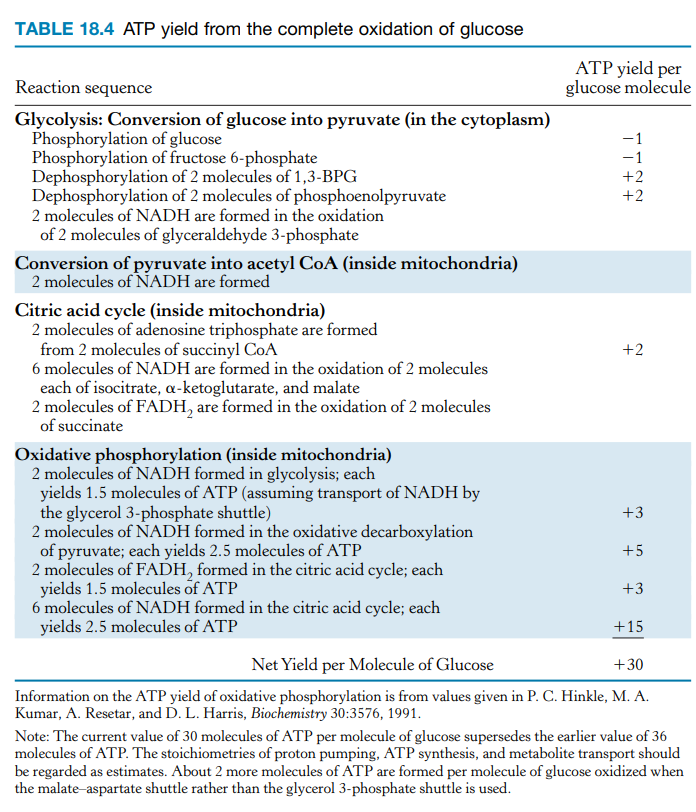A violation of the First Law? The complete combustion of glucose to CO 2 and H 2 O yields 30 ATP, as shown in Table 18.4 . However, the synthesis of glucose requires only 18 ATP. How is it possible that glucose synthesis from CO 2 and H 2 O requires only 18 ATP , but combustion to CO 2 and H 2 O yields 30 ATP? Is it a violation of the First Law of Thermodynamics , or perhaps a miracle?
A violation of the First Law? The complete combustion of glucose to CO 2 and H 2 O yields 30 ATP, as shown in Table 18.4 . However, the synthesis of glucose requires only 18 ATP. How is it possible that glucose synthesis from CO 2 and H 2 O requires only 18 ATP , but combustion to CO 2 and H 2 O yields 30 ATP? Is it a violation of the First Law of Thermodynamics , or perhaps a miracle?
Human Physiology: From Cells to Systems (MindTap Course List)
9th Edition
ISBN:9781285866932
Author:Lauralee Sherwood
Publisher:Lauralee Sherwood
Chapter2: Cell Physiology
Section: Chapter Questions
Problem 10RE: Using the answer code on the right, indicate which form of energy production is being described: 1....
Related questions
Question
A violation of the First Law? The complete combustion of glucose to CO 2 and H 2 O yields 30 ATP, as shown in Table 18.4 . However, the synthesis of glucose requires only 18 ATP. How is it possible that glucose synthesis from CO 2 and H 2 O requires only 18 ATP , but combustion to CO 2 and H 2 O yields 30 ATP? Is it a violation of the First Law of

Transcribed Image Text:TABLE 18.4 ATP yield from the complete oxidation of glucose
Reaction sequence
Glycolysis: Conversion of glucose into pyruvate (in the cytoplasm)
Phosphorylation of glucose
Phosphorylation
Dephosphorylation
of fructose 6-phosphate
of 2 molecules of 1,3-BPG
Dephosphorylation of 2 molecules of phosphoenolpyruvate
2 molecules of NADH are formed in the oxidation
of 2 molecules of glyceraldehyde 3-phosphate
Conversion of pyruvate into acetyl CoA (inside mitochondria)
2 molecules of NADH are formed
Citric acid cycle (inside mitochondria)
2 molecules of adenosine triphosphate are formed
from 2 molecules of succinyl CoA
6 molecules of NADH are formed in the oxidation of 2 molecules
each of isocitrate, a-ketoglutarate, and malate
2 molecules of FADH, are formed in the oxidation of 2 molecules
of succinate
Oxidative phosphorylation (inside mitochondria)
2 molecules of NADH formed in glycolysis; each
yields 1.5 molecules of ATP (assuming transport of NADH by
the glycerol 3-phosphate shuttle)
2 molecules of NADH formed in the oxidative decarboxylation
of pyruvate; each yields 2.5 molecules of ATP
2 molecules of FADH, formed in the citric acid cycle; each
yields 1.5 molecules of ATP
6 molecules of NADH formed in the citric acid cycle; each
yields 2.5 molecules of ATP
ATP yield per
glucose molecule
TT++
-1
+2
+2
+2
+3
+5
+3
+15
Net Yield per Molecule of Glucose
+30
Information on the ATP yield of oxidative phosphorylation is from values given in P. C. Hinkle, M. A.
Kumar, A. Resetar, and D. L. Harris, Biochemistry 30:3576, 1991.
Note: The current value of 30 molecules of ATP per molecule of glucose supersedes the earlier value of 36
molecules of ATP. The stoichiometries of proton pumping, ATP synthesis, and metabolite transport should
be regarded as estimates. About 2 more molecules of ATP are formed per molecule of glucose oxidized when
the malate-aspartate shuttle rather than the glycerol 3-phosphate shuttle is used.
Expert Solution
This question has been solved!
Explore an expertly crafted, step-by-step solution for a thorough understanding of key concepts.
Step by step
Solved in 3 steps

Follow-up Questions
Read through expert solutions to related follow-up questions below.
Follow-up Question
Please show the energetical math for why it is not a violation of the first law, such as by including talking of NADH (or NADPH) and the like.
Solution
Recommended textbooks for you

Human Physiology: From Cells to Systems (MindTap …
Biology
ISBN:
9781285866932
Author:
Lauralee Sherwood
Publisher:
Cengage Learning

Biochemistry
Biochemistry
ISBN:
9781305577206
Author:
Reginald H. Garrett, Charles M. Grisham
Publisher:
Cengage Learning


Human Physiology: From Cells to Systems (MindTap …
Biology
ISBN:
9781285866932
Author:
Lauralee Sherwood
Publisher:
Cengage Learning

Biochemistry
Biochemistry
ISBN:
9781305577206
Author:
Reginald H. Garrett, Charles M. Grisham
Publisher:
Cengage Learning


Biology 2e
Biology
ISBN:
9781947172517
Author:
Matthew Douglas, Jung Choi, Mary Ann Clark
Publisher:
OpenStax